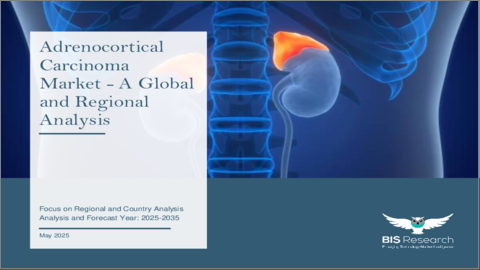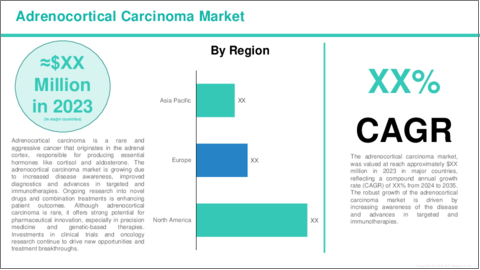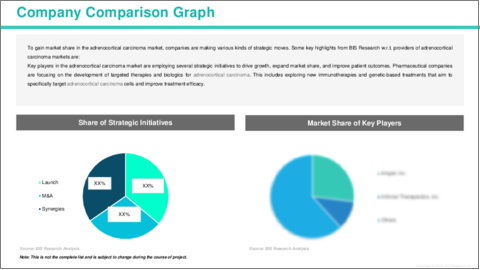|
|
市場調査レポート
商品コード
1724171
円形脱毛症の世界市場:薬剤クラス・地域別の分析・予測 (2025~2035年)Alopecia Areata Market - A Global and Regional Analysis: Focus on Drug Class and Region - Analysis and Forecast, 2025-2035 |
||||||
カスタマイズ可能
|
|||||||
| 円形脱毛症の世界市場:薬剤クラス・地域別の分析・予測 (2025~2035年) |
|
出版日: 2025年05月14日
発行: BIS Research
ページ情報: 英文 100 Pages
納期: 1~5営業日
|
全表示
- 概要
- 図表
- 目次
円形脱毛症は、自己免疫疾患の一種で、身体の免疫システムが誤って毛包を攻撃することにより、通常は小さな円形のパッチ状に突然脱毛が生じる病気です。
男女問わずあらゆる年齢層に影響を及ぼす可能性があり、心理的・社会的に大きな影響をもたらすこともあります。世界の円形脱毛症の治療に関する市場は、認知度の向上、医学研究の進展、新たな治療法の登場により、大きく成長してきました。現在注目されている治療法の一つに、JAK阻害薬があります。その一例として、リトレシチニブ (商品名リトフロ:Litfulo) は、FDAによって思春期の円形脱毛症治療薬として承認されました。この承認は、これまで治療の選択肢が限られていた患者にとって、重要な前進となるものでした。
円形脱毛症市場の主な成長要因の一つは、円形脱毛症の有病率の増加です。円形脱毛症は世界人口のおよそ2%に影響を及ぼしており、その有病率は着実に上昇しています。ストレスや大気汚染、ライフスタイルの変化といった環境要因が、この増加に寄与しています。また、自己免疫疾患全体の発症率が増加していることも、円形脱毛症を発症する人が増えている背景にあります。例えば、米国皮膚科学会 (American Academy of Dermatology) のデータによると、米国だけでも約680万人が何らかの形で脱毛症に悩まされていると推定されています。
コルチコステロイドや局所免疫療法のような従来の治療法はある程度有効でしたが、毛包に対する自己免疫攻撃に関与する経路を遮断するJAK阻害剤のような新規治療薬によって、現在市場は大きく変わりつつあります。これまで一般的に使用されてきた治療法としては、コルチコステロイドや外用免疫療法があり、一定の効果はあるものの、現在ではJAK阻害薬のような新しい治療法が登場し、市場に大きな変革をもたらしています。JAK阻害薬は、毛包に対する自己免疫反応に関与する経路をブロックすることで効果を発揮します。その画期的な治療例の一つが、デュピクセント (デュピルマブ) で、中等度から重度のアトピー性皮膚炎の治療薬として使用されているモノクローナル抗体ですが、円形脱毛症の患者にも有望な効果が示されています。2023年には、リトレシチニブが思春期の円形脱毛症に対して承認され、こうした標的療法の進展が、患者に新たな希望をもたらしていることを示す好例となっています。
当レポートでは、世界の円形脱毛症の市場を調査し、主要動向、市場影響因子の分析、法規制環境、技術・特許の動向、ケーススタディ、市場規模の推移・予測、各種区分・地域/主要国別の詳細分析、競合情勢、主要企業のプロファイルなどをまとめています。
目次
エグゼクティブサマリー
第1章 市場:業界展望
- 市場動向
- 規制の枠組み
- 臨床試験分析
- 疫学分析
- 市場力学
- 影響分析
- 市場促進要因
- 市場の課題
- 市場機会
第2章 世界の円形脱毛症市場:薬剤クラス別
- コルチコステロイド
- JAK (ヤヌスキナーゼ) 阻害剤
- その他
第3章 世界の円形脱毛症市場:地域別
- 北米
- 欧州
- アジア太平洋
- 主な調査結果
- 市場力学
- 市場規模と予測
第4章 世界の円形脱毛症市場:競合情勢と企業プロファイル
- 主な展開・戦略
- 企業プロファイル
- Eli Lilly and Company
- Pfizer Inc
- Sun Pharmaceutical Industries Ltd
- Arcutis Biotherapeutics
- Bristol-Myers Squibb
- AbbVie
- Regeneron Pharmaceuticals
- Aclaris Therapeutics
第5章 調査手法
List of Figures
- Figure: Global Alopecia Areata Market (by Region), $Million, 2024 and 2035
- Figure: Global Alopecia Areata Market Coverage
- Figure: Global Alopecia Areata Market Key Trend Analysis
List of Tables
- Table: Global Alopecia Areata Market Dynamics, Impact Analysis
- Table: Global Alopecia Areata Market (by Drug Class), $Million, 2023-2035
- Table: Global Alopecia Areata Market (by Region), $Million, 2023-2035
Global Alopecia Areata Market, Analysis and Forecast: 2025-2035
Alopecia areata is an autoimmune condition in which the body's immune system mistakenly attacks hair follicles, leading to sudden hair loss, typically in small patches. It can affect both men and women of all ages, with a significant psychological and social impact. The global market for alopecia areata treatments has experienced substantial growth due to increasing awareness, advancements in medical research, and the introduction of novel therapeutic options. One of the notable examples of current treatments is JAK inhibitors like Ritlecitinib (brand name Litfulo), which received approval by the U.S. FDA for the treatment of alopecia areata in adolescents. This approval marked a significant advancement, given the earlier limited treatment options available for those suffering from this condition.
One of the key drivers of the alopecia areata market is increasing prevalence of alopecia areata. Alopecia areata affects around 2% of the global population, and its prevalence has been steadily increasing. Environmental factors like stress, pollution, and lifestyle changes are contributing to this rise. The increasing incidence of autoimmune disorders overall also means more individuals are prone to developing alopecia areata. For instance, data from the American Academy of Dermatology estimates that approximately 6.8 million people in the U.S. alone have been affected by some form of alopecia.
Moreover, traditional treatments like corticosteroids and topical immunotherapy have been somewhat effective, but the market is now being transformed by novel therapies such as JAK inhibitors, which block the pathways involved in the autoimmune attack on hair follicles. One such breakthrough is Dupixent (dupilumab), a monoclonal antibody used to treat moderate-to-severe atopic dermatitis, which has also shown promise for patients with alopecia areata. The approval of Ritlecitinib for alopecia in adolescents in 2023 is another example of how targeted therapies are creating new hope for those affected by the condition.
Despite the market's growth, there are several challenges that hinder the wider adoption and accessibility of treatments. Advanced treatments such as biologics (e.g., Ritlecitinib and Dupixent) are often expensive, with some costing thousands of dollars per treatment cycle. This high cost of treatment limits access for many patients, particularly in developing regions where healthcare budgets are constrained. The cost barrier is significant in countries outside the U.S. and Europe, where access to biologics is more limited. The high cost of Dupixent, for example, is a point of concern for patients seeking affordable care.
Moreover, not all patients respond the same way to therapies. While JAK inhibitors have shown great promise for some individuals with alopecia areata, they may not work equally well for everyone. The variability in patient responses has led to the need for personalized treatment plans, which complicates the management of the condition and may increase healthcare costs.
In addition, many regions, particularly in Africa, Asia, and Latin America, have limited access to newer treatments due to logistical, financial, and infrastructural barriers. Although global healthcare access is improving, the availability of cutting-edge treatments like JAK inhibitors remains a challenge in these underserved markets.
Market Segmentation:
Segmentation 1: by Drug Class
- Corticosteroids
- JAK (Janus Kinase) Inhibitors
- Others
Segmentation 2: by Region
- North America
- Europe
- Asia-Pacific
The alopecia areata market is experiencing several key emerging trends. One notable trend is the rise of personalized medicine, where treatment plans are tailored to an individual's genetic profile, disease progression, and response to therapy. Biotech companies are increasingly investing in genetic research and biomarkers to identify which patients will benefit most from specific treatments. Another trend is the growing demand for non-invasive therapies, such as topical corticosteroids, minoxidil solutions, and low-level laser therapies. These options are becoming more popular due to their reduced side effects and ease of use, offering more affordable and accessible solutions, especially in regions with limited access to biologics. As healthcare access expands globally, biologic therapies like JAK inhibitors are also gaining traction in emerging markets, with pharmaceutical companies working to improve accessibility through patient assistance programs and distribution partnerships.
In conclusion, the Alopecia Areata (AA) market is positioned for continued growth, driven by advancements in biologic therapies, rising awareness, and increased healthcare access worldwide. Although challenges such as high treatment costs and variability in treatment response remain, the emergence of new therapies, personalized medicine, and the global expansion of access to effective treatments are poised to enhance the management of alopecia areata. The market is also benefiting from the growing emphasis on mental health and the psychological impact of hair loss, leading to more patient-centered care. As innovation continues, both large pharmaceutical companies and smaller biotech firms will drive competition and improve the quality of life for individuals living with alopecia areata.
Table of Contents
Executive Summary
Scope and Definition
Market/Product Definition
Inclusion and Exclusion
Key Questions Answered
Analysis and Forecast Note
1. Markets: Industry Outlook
- 1.1 Introduction
- 1.2 Market Trends
- 1.3 Regulatory Framework
- 1.4 Clinical Trial Analysis
- 1.5 Epidemiology Analysis
- 1.6 Market Dynamics
- 1.6.1 Impact Analysis
- 1.6.2 Market Drivers
- 1.6.3 Market Challenges
- 1.6.4 Market Opportunities
2. Global Alopecia Areata Market, by Drug Class, ($Million), 2023-2035
- 2.1 Corticosteroids
- 2.2 JAK (Janus Kinase) Inhibitors
- 2.3 Others
3. Global Alopecia Areata Market, by Region, ($Million), 2023-2035
- 3.1 North America
- 3.1.1 Key Findings
- 3.1.2 Market Dynamics
- 3.1.3 Market Sizing and Forecast
- 3.1.3.1 North America Alopecia Areata Market, by Country
- 3.1.3.1.1 U.S.
- 3.1.3.1 North America Alopecia Areata Market, by Country
- 3.2 Europe
- 3.2.1 Key Findings
- 3.2.2 Market Dynamics
- 3.2.3 Market Sizing and Forecast
- 3.2.3.1 Europe Alopecia Areata Market, by Country
- 3.2.3.1.1 Germany
- 3.2.3.1.2 U.K.
- 3.2.3.1.3 France
- 3.2.3.1.4 Italy
- 3.2.3.1.5 Spain
- 3.2.3.1 Europe Alopecia Areata Market, by Country
- 3.3 Asia Pacific
- 3.3.1 Key Findings
- 3.3.2 Market Dynamics
- 3.3.3 Market Sizing and Forecast
- 3.3.3.1 Asia Pacific Alopecia Areata Market, by Country
- 3.3.3.1.1 Japan
- 3.3.3.1 Asia Pacific Alopecia Areata Market, by Country
4. Global Alopecia Areata Market: Competitive Landscape and Company Profiles
- 4.1 Key Developments and Strategies
- 4.1.1 Mergers and Acquisitions
- 4.1.2 Synergistic Activities
- 4.1.3 Business Expansions and Funding
- 4.1.4 Product Launches and Approvals
- 4.1.5 Other Activities
- 4.2 Company Profiles
- 4.2.1 Eli Lilly and Company
- 4.2.1.1 Overview
- 4.2.1.2 Top Products / Product Portfolio
- 4.2.1.3 Target Customers/End-Users
- 4.2.1.4 Key Personnel
- 4.2.1.5 Analyst View
- 4.2.2 Pfizer Inc
- 4.2.2.1 Overview
- 4.2.2.2 Top Products / Product Portfolio
- 4.2.2.3 Target Customers/End-Users
- 4.2.2.4 Key Personnel
- 4.2.2.5 Analyst View
- 4.2.3 Sun Pharmaceutical Industries Ltd
- 4.2.3.1 Overview
- 4.2.3.2 Top Products / Product Portfolio
- 4.2.3.3 Target Customers/End-Users
- 4.2.3.4 Key Personnel
- 4.2.3.5 Analyst View
- 4.2.4 Arcutis Biotherapeutics
- 4.2.4.1 Overview
- 4.2.4.2 Top Products / Product Portfolio
- 4.2.4.3 Target Customers/End-Users
- 4.2.4.4 Key Personnel
- 4.2.4.5 Analyst View
- 4.2.5 Bristol-Myers Squibb
- 4.2.5.1 Overview
- 4.2.5.2 Top Products / Product Portfolio
- 4.2.5.3 Target Customers/End-Users
- 4.2.5.4 Key Personnel
- 4.2.5.5 Analyst View
- 4.2.6 AbbVie
- 4.2.6.1 Overview
- 4.2.6.2 Top Products / Product Portfolio
- 4.2.6.3 Target Customers/End-Users
- 4.2.6.4 Key Personnel
- 4.2.6.5 Analyst View
- 4.2.7 Regeneron Pharmaceuticals
- 4.2.7.1 Overview
- 4.2.7.2 Top Products / Product Portfolio
- 4.2.7.3 Target Customers/End-Users
- 4.2.7.4 Key Personnel
- 4.2.7.5 Analyst View
- 4.2.8 Aclaris Therapeutics
- 4.2.8.1 Overview
- 4.2.8.2 Top Products / Product Portfolio
- 4.2.8.3 Target Customers/End-Users
- 4.2.8.4 Key Personnel
- 4.2.8.5 Analyst View
- 4.2.1 Eli Lilly and Company





